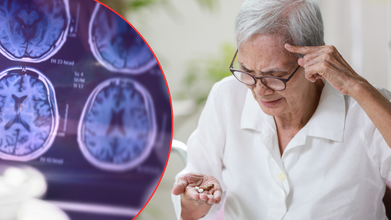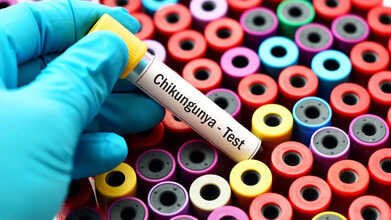- Health Conditions A-Z
- Health & Wellness
- Nutrition
- Fitness
- Health News
- Ayurveda
- Videos
- Medicine A-Z
- Parenting
- Web Stories
Do Green Crackers Really Make A Difference When It Comes To Pollution And Respiratory Health?

Credits: Canva
Days before Diwali celebrations took off, the national capital of India, Delhi has already logged 211 in the Air Quality Index (AQI), categorizing the quality as ‘Poor’. The Central Air Quality Management (CAQM), as a result, imposed Stage 1 measures under the Graded Response Action Plan (GRAP) across Delhi-NCR, which will ensure dust control measures, including the use of anti-smog guns around the construction and demolition sites and areas with higher AQI.
As Delhi prepares itself for Diwali, this year, the Supreme Court of India allowed the sale and bursting of green firecrackers in the city, after lifting last year’s blanket ban on all crackers.
The Supreme Court permitted the sale between October 18 and 21 and limited the timings to 6-7am and 8-10pm.The Chief Justice of India Bhushan R Gavai said, “We have to take a balanced approach permitting it in moderation while not compromising with the environment.”
However, what one needs to understand is whether green crackers really work for the environment.
Are Green Crackers Also Health Threats?
While it is true that green crackers are designed to cut emissions of particulate matter and harmful gases by 30 to 40% and keep the noise levels below 120 decibels, a joint study by Delhi Technological University (DTU) and IIT Roorkee shows that even green crackers release large volumes of ultrafine particles. These particles are smaller than 100 nanometers and can penetrate deep into the lungs.
Dr Rajeev Kumar Mishra, who is the senior researcher at DTU as reported by The Indian Express, said that more research must be done to assess atmospheric emissions of green crackers and their health impacts.
These small particles present in the green crackers can also become a hinder for people with existing pulmonary and respiratory issues, asthma, COPD, and heart problems.
Green crackers also emit fine and ultrafine particles like PM2.5 and PM1, and they are tiny enough to go deep in the lungs and even enter the blood streams. These tiny particles also contain small amounts of metals and chemicals which can cause breathing problems or worsen the issues in people with existing breathing problems.
Many experts also note that green crackers, while producing less sound, still exceed safe auditory limits. It can also cause relentless or disturbed sleep.
What Are The Health Risks?
As per the World Health Organization (WHO), air pollution can lead to stroke, ischaemic heart disease, CPOD, lung cancer, pneumonia, and cataracts.
Dr Sanjay Jain, a Delhi-based ENT and a member of DocTube also noted an increase in the number of patients with respiratory issues. "I have seen a notable increase in patients with upper respiratory tract infections, chronic sinusitis, and allergic rhinitis, which are directly linked to rising pollution levels," he says. From his experience, he has noticed a rough increase of 30 to 40% of patients with pollution-related ENT issues.
Dr Jain says that prolonged exposure to pollution can cause chronic ear infections in children due to inflammation in the Eustachian tube. "This is not commonly recognized by people," he says.
The act of burning firecrackers emits harmful and toxic gases such as carbon monoxide, which facilitate air pollution. This can cause health problems including skin irritation, respiratory issues, cancer, and asthma.
Google Vs Chat GPT: Study Finds Which Medium Give Better Health Advice

(Credit-Canva)
Search engines like Google and Bing, and AI chatbots like ChatGPT and GPT-4, are now major sources of health information. But how reliable are they?
A new research published in the NPJ Digital Medicine tested four major search engines and seven different large AI models, including leading programs like ChatGPT and GPT-4, by asking them 150 medical questions. Their study looked at how accurate the answers were, how much the results changed based on how the question was asked, and whether giving the AI access to search results helped.
Which Gave Better Answers: AI or Search Engines?
While AI Chatbots, with 80% accuracy, generally outperformed Search Engines, with 50-70% accuracy, on direct health questions, the study found that AI chatbots are good, but their mistakes are worrying.
Confidence in Errors
The biggest and most dangerous problem was that the AI sometimes gave confidently wrong answers that directly disagreed with established medical facts. This is highly risky in a health setting.
Overall Accuracy
The AI chatbots generally did better than search engines, correctly answering about 80% of the questions. The best performers were typically GPT-4, ChatGPT, Llama3, and MedLlama3.
Precision Problem
Search engines like Google usually return answers that are correct when they directly address the question, but they often clutter the results with information that is incomplete or off-topic. They struggled with giving a straight "yes" or "no" answer.
User Habits
The study simulated a "lazy" user, who just trusts the first answer, and a "diligent" user, who checks three sources. Surprisingly, the "lazy" users were sometimes just as accurate as the diligent ones, suggesting that top-ranked results are often good, but this is a risk if a highly ranked answer happens to be wrong.
Bing was the best among search engines, but it wasn't significantly better than Google, Yahoo!, or DuckDuckGo.
How You Ask The Question Matters
The AI's accuracy was highly sensitive to how the question was phrased. Using an "expert" prompt like asking the AI to cite reputable medical sources generally led to better, more medically sound answers, even if they were sometimes less direct.
Giving the AI the top search results before it answered (retrieval augmentation) usually improved performance, especially for smaller AI models. However, this didn't always help; if the search results given to the AI were irrelevant or low-quality, the AI's answer could actually get worse. More information isn't always better.
Things to Keep In Mind
Some points noted by the researchers was,
- Questions about COVID-19 were easier for both AI and search engines, likely because of the huge amount of data available about the pandemic.
- While AI is powerful, its tendency to be swayed by how you word the question and its confident errors mean we need to be very cautious about using it for medical advice.
- The overall conclusion is that AI models are promising for health information, but they are not yet fully reliable on their own. Combining them with high-quality search results is likely the best way forward, but only if the search results fed to the AI are trustworthy.
Eye Movement Tracker Can Reveal The Risk Of Alzheimer's Years Before Symptoms Appear: Study

(Credit-Canva)
A recent scientific study found an exciting new way to check if someone is likely to get Alzheimer's disease due to their genetics. Instead of current medical tests, which are often costly, complex, and invasive, this new method uses simple eye-tracking technology. This means diagnosing the risk could become much easier for patients and more affordable for healthcare systems.
As you may know, there is currently no cure for Alzheimer's disease. This is a neurodegenerative disease that can affect a person’s memory, skills, as well as behavior. The best way to deal with this disease is by diagnosing it early, so that doctors can provide medicine and treatment options to delay the onset and manage the symptoms. However, it is not easy to spot the symptoms, so how can one know for certain whether they have Alzheimer's disease or not?
How Can Eye Trackers Detect Alzheimer’s Disease
This research, which involved scientists from the University of Strathclyde, looked closely at how well this new technique works. The technology is a specific system called ViewMind Atlas. It works by monitoring a person's tiny, subtle eye movements. Then, Artificial Intelligence (AI) software analyzes these movements.
Since the eyes are closely linked to the brain, the way they move can tell doctors about the brain's health and function. The most important part is that this system can successfully identify the genetic risk in people years before they start showing any actual memory loss or other Alzheimer’s symptoms.
How Accurate Is This Eye Tracking Test?
To test the system, the researchers studied a group of people from extended families in Colombia who have a known genetic mutation that causes Alzheimer’s. The results were incredibly promising:
For the family members who were already showing symptoms of the disease, the ViewMind Atlas test was 100% accurate in identifying them.
More remarkably, for those who carried the gene but didn't have any symptoms yet (asymptomatic), the test was 96% accurate at correctly identifying their risk. The AI model essentially learned to look at the patterns of eye movement and use them to tell apart the people who had or were likely to get Alzheimer's from those who weren't.
Can This Help Improve Early Diagnosis Rate?
The research team found this eye-tracking test detects the disease earlier than standard cognitive tests, which often fail to flag a problem until it is well underway. The lead scientist, Professor Mario Parra Rodriguez, explained why this is such a big deal. He pointed out that today's common tests are "expensive and invasive," often requiring hospital procedures.
The ViewMind Atlas system, however, helps doctors predict Alzheimer’s risk years in advance. This is key for doctors, who often struggle to figure out if a patient’s mild forgetfulness is just a normal part of getting older or a serious risk of dementia. This new tool could help them act quickly to treat or manage the risk instead of having to wait for the disease to fully develop.
As New York Reports Its First Chikungunya Case, Experts Warn Who Is Most at Risk

Credits: Canva
A resident in the suburbs of New York City has tested positive for chikungunya, which is a mosquito-borne virus more commonly seen in South America and not reported on the U.S. mainland in over a decade. Health officials confirmed that the virus, which often causes fever and joint pain, was identified in a Long Island patient who began showing symptoms in August after traveling outside the local area, though not internationally.
The infection likely came from a mosquito bite, but it is unclear exactly where. So far, the virus has not been detected in local mosquito populations and cannot spread directly from person to person. As the virus reaches New York, it’s important to understand who is more vulnerable to chikungunya.
Who Is More At Risk For Chikungunya?
According to the World Health Organization, certain groups are more susceptible to severe chikungunya. Older adults, newborns, pregnant women, and individuals with pre-existing conditions such as high blood pressure, diabetes, or heart disease are at higher risk of complications or slower recovery. While chikungunya rarely leads to death, it can produce sudden high fever, headaches, fatigue, rash, nausea, and red eyes.
Symptoms typically appear 2 to 7 days after being bitten by an infected mosquito. Most people recover within a couple of weeks, but some may experience lingering joint and muscle pain for months or even years after infection.
Where Is Chikungunya Found?
Originally limited to Africa and Asia, chikungunya has now spread rapidly since 2004. Today, more than one-third of the global population lives in areas where the virus can be transmitted. These regions include parts of the Americas, Africa, Asia, Europe, and islands in the Caribbean as well as the Indian and Pacific Oceans, according to Mayo Clinic.
Should You Be Worried About The Chikungunya Spread In The US?
Most people recover within 1 to 2 weeks without additional symptoms. However, some develop chronic chikungunya arthritis, with joint and muscle pain lasting months or years, affecting at least 40% of those infected.
Death from chikungunya is rare, but the virus can cause serious issues in vulnerable groups, including older adults, people with chronic conditions such as diabetes or high blood pressure, young children, and pregnant individuals who could transmit the virus to their babies. Complications may involve the eyes, heart, or nervous system. Fortunately, a previous infection usually provides protection against future infections.
Chikungunya: What’s Happening in the United States?
The New York case marks the first locally acquired instance in the U.S. since 2015, meaning the patient contracted the virus without traveling elsewhere. Ten years ago, a single case was reported in Texas, according to the Centers for Disease Control and Prevention (CDC), and two cases occurred in U.S. territories in 2019.
This is also the first locally acquired case ever detected in New York, said the state Health Department. Health officials explained that transmission occurs when a mosquito bites an infected traveler, becomes infected, and then bites another person. The mosquito species known to carry chikungunya, Aedes albopictus, exists in parts of downstate New York. People are advised to prevent bites by wearing long sleeves and removing standing water from items like flowerpots. However, cooler nighttime temperatures in New York currently make the risk of transmission “very low,” said State Health Commissioner James McDonald.
Although locally acquired cases have been almost nonexistent in recent years, the CDC has recorded several travel-related infections in the U.S., including 199 cases in 2024 and 152 in 2023.
© 2024 Bennett, Coleman & Company Limited

